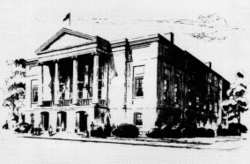|
It’s been nearly 33 years since Judge Cox noted that, in trials by court-martial: The Government has the functional equivalent of an unlimited number of peremptory challenges. . . . The statutory authority to choose the members necessarily includes the corollary right not to choose. United States v. Carter, 25 M.J. 471, 478 (C.A.A.F. 1998) (concurring opinion by current Senior Judge Walter T. Cox III, of the United States Court of Appeals for the Armed Forces). In the above quote, Judge Cox was referring to the fact that, in the military justice system, the convening authority who wields prosecutorial discretion also exercises the power (under Article 25(e)(2) of the Code) to pick the members of the court-martial who will decide the case. That is, as this column has discussed in the past, a power which some have described as – as the definition of the word “peremptory” suggests – imperious, dictatorial, and unconstitutional. But, the government’s selection and exclusion of court-martial members starts long before a convening authority sits down with pen in-hand to pick from a list of names of personnel assigned to his or her command. In the military, the process of selecting court-martial members begins at the Military Entrance Processing Station. The process of excluding members from the military’s general venire occurs in promotion boards, force shaping boards, and through other personnel management actions. Those personnel practices are the actual means by which the government chooses who will be in its military venire. Those processes are how the government truly exercises its “unlimited number of peremptory challenges.” It is therefore imperative that those practices be free of racial disparity. Unfortunately, that does not appear to be the case. Just last week, Reuters reported that “a long-withheld Defense Department survey” revealed: 31.2% of Black servicemembers reported suffering racial discrimination, harassment or both, compared with 23.3% and 21% for Asian and Hispanic troops surveyed, respectively[.] The survey Reuters was referring to is the 2017 Workplace and Equal Opportunity Survey of Active Duty Members (WEOA), available for download on the website of the Defense Research, Surveys, and Statistics Center, under the “Equal Opportunity Surveys” header, here. Some additional results from Table 3 of the survey include: 6% of black servicemembers reported having “someone from work [make] it harder for [them] to get a military promotion” due to race or ethnicity, as compared to 1.6% of white respondents. Additionally, Table 12 of the survey showed that of black servicemembers who experienced discriminatory behavior, the experience caused 36% to “[think] about getting out of [the] Service.” Table 15 of the survey showed that only 44% of black servicemembers who reported discriminatory behavior felt that the “situation was corrected.” These sorts of experiences and their effects on both recruiting and retention may explain why, as the Congressional Research Service found in 2019: [T]he active duty enlisted corps is more racially diverse than the U.S. resident population[.] . . . However, in the officer corps, and especially at the senior leadership level, racial and ethnic minorities are underrepresented. 13.7% of the U.S. Resident Population between the ages of 18 and 64 are black, but only 8.1% of active duty military officers are black. When the officer corps is compared to post-secondary degree holders in the civilian U.S. Resident Population, the disparities are less pronounced. However, the relevance of that comparison is diminished by two key facts: First, of the military personnel, officer and enlisted, who possess a post-secondary degree, 36% are enlisted. If the goal is to have well-educated members on court-martial panels, then there is no basis to exclude enlisted personnel, and yet enlisted personnel are disfavored for court-martial duty as a matter of law. Second, jurors in civilian trials do not need to hold post-secondary degrees as a condition-precedent to serving on juries. That is a reflection of the deep-seated preference in American criminal law for “the common sense judgment of a group of laymen.” Williams v. Florida, 399 U.S. 78, 100 (1970). The military jurisdiction’s rejection of a preference for common sense cannot reasonably serve as a justification for the racial disparity that results from that rejection. To explain the racial disparity in the composition of the active duty officer corps, the Congressional Research Service offers: [C]areer success is cumulative and . . . racial and ethnic minority officers, on average, were less likely to have achieved the early career milestones that are correlated with improved promotion prospects. These persistent disparities in the composition of the military officer corps translate into a parallel disparity in the military venire. That is a cause for concern. And, the Supreme Court’s handling of similar systemic disparities suggests it is not a concern for the accused alone: Defendants in criminal proceedings do not have the only cognizable legal interest in nondiscriminatory jury selection. People excluded from juries because of their race are as much aggrieved as those indicted and tried by juries chosen under a system of racial exclusion. Carter v. Jury Commission, 396 U.S. 320, 330 (1970). That precedent suggests that the failure of the U.S. Government to ensure a racially and ethnically diverse officer corps has potentially poisoned the military venire in a manner that violates not only the accused’s rights, but also the rights of all Americans to participate equally in disciplining their armed forces. As the Supreme Court explained in Batson v. Kentucky: The harm from discriminatory jury selection extends beyond that inflicted on the defendant and the excluded juror to touch the entire community. 476 U.S. 79, 87 (1986). Court-martial panels are not the only aspect of the military justice system that is belabored by the personnel system’s failure to ensure racial and ethnic equity. The fact that, as a result of those deficient personnel systems, commanders themselves lack diversity raises its own concerns. For example, in the past, this column has discussed the long-standing disparities in the manner in which prosecutorial and punishment discretion is exercised: here and here. But the causal link between that disparity and the lack of commander diversity is unproven. There is a greater problem presented by a lack of commander diversity, and that problem is structural in nature. In Carter v. Jury Commission, as discussed above, the Supreme Court prohibited systems that exclude jurors based on race. But, the decision went further. It also held that the government must not discriminate based on race when it selects the people who pick the potential jurors. In that case, the State of Alabama used a jury commission to select the venire: [W]e may assume that the State may no more exclude Negroes from service on the jury commission because of their race than from the juries themselves. 396 U.S. at 338. Under Carter v. Jury Commission, the government’s failure to ensure racial and ethnic diversity among the senior officers who, as convening authorities, pick from the military venire is just as concerning as the government’s failure to ensure racial and ethnic diversity of the officers in the military venire. Isaac Kennen Scholarship Editor
3 Comments
AnnoyingProle
1/26/2021 10:45:09 am
While I don't want to minimize the racial disparities present in the services, and agree it's a continuing problem that has to be worked on--I think it's useful when considering issues like this to compare it to the backdrop of the rest of US society.
Reply
Cloudesley Shovell
1/26/2021 08:14:51 pm
Well said AP.
Reply
1984
1/27/2021 04:38:58 pm
Many Jurisdictions send juror notices to minorities in equal numbers as whites.
Reply
Your comment will be posted after it is approved.
Leave a Reply. |
Links
CAAF -Daily Journal -Current Term Opinions ACCA AFCCA CGCCA NMCCA Joint R. App. Pro. Global MJ Reform LOC Mil. Law Army Lawyer Resources Categories
All
Archives
April 2022
|



